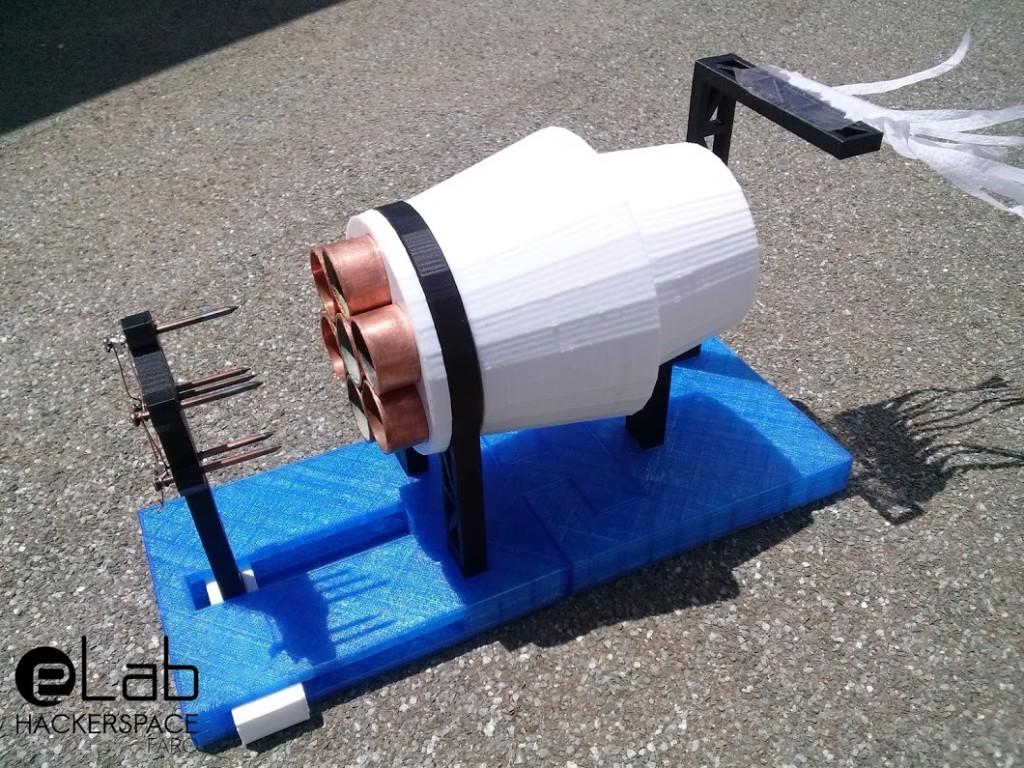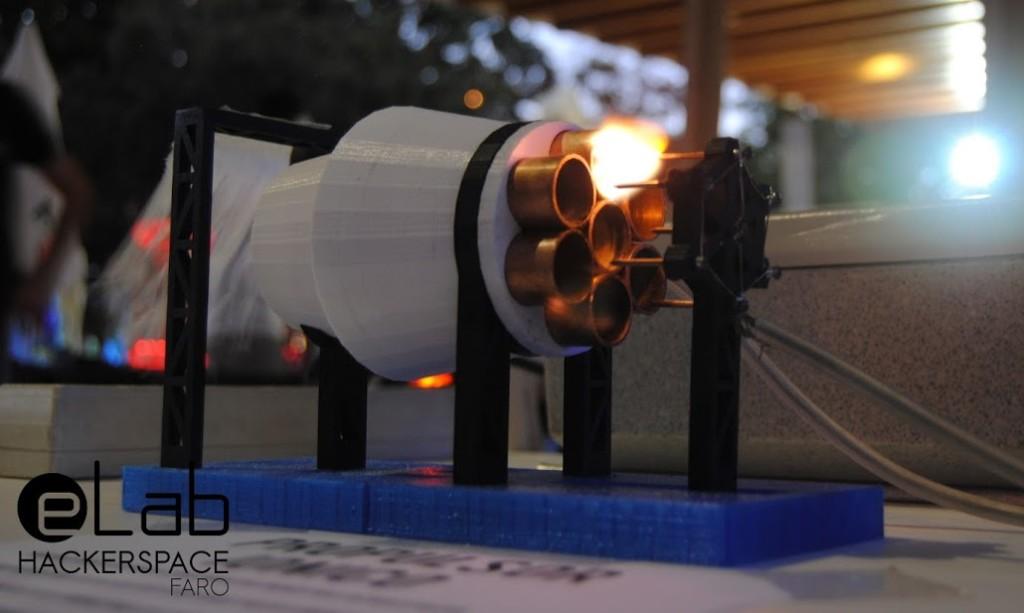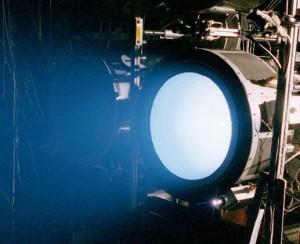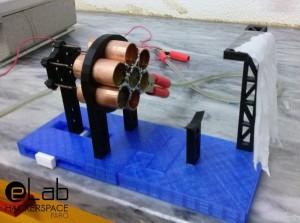While it may sound like something that Captain Kirk asks Sulu to set to maximum, an ion thruster is not science fiction but actually a working technology that is available today. Ion thrusters are used on long-range spacecraft and on satellites to control their orientation and position in orbit. They work by generating beams of ions to create thrust that, in the vacuum of space, can actually allow spacecraft to reach some pretty impressive speeds using a very small amount of power. In space, ion drives are generally powered by solar panels, or for long-range spacecraft, nuclear power. However, it is possible to make an ion drive in Earth’s atmosphere, and while you won’t be able to fly anything with it, it is still a great way to demonstrate the science behind them.
A Portuguese engineer named João Duarte was browsing the internet when he stumbled on a demonstration of the working principles behind ion thrusters and decided that he wanted to build his own. As one of the founders of his local makerspace, eLab Hackerspace, he had access to everything that he would need, and was actually looking for a project to take with him to Lisbon Maker Faire. Because it is always cool to see a flow of air without any moving parts, he thought that a simplified version of this complex technology would be a great project to demonstrate for the show’s visitors. And not only did it just sound like a fun project, building his own ion thruster was a project right up Duarte’s alley.
“First of all, I love space! So, everything related to space is always attractive to me. Another thing I love is to work with high voltage! As an electrical and electronics engineer I’m always involved in interesting projects, but high voltage usually tops everything else. And finally there’s 3D printing, which is relatively new to me, even though I had a previous success with my DNA Lamp. I thought I could use my new learned skills to make it even more special looking, by creating some kind of launching platform looking or engine testing facility, using 3D printed parts,” Duarte told me via email.
 Once he knew exactly what it was that he would need to build his ion thruster, Duarte started designing the whole thing in Tinkercad. Other than some copper tubing, copper plated nails, a few bits of wire and the power source, almost the entire thruster is made of 3D printed components, which are all available for download on Thingiverse. Once he had everything that he needed, it was time for Duarte to assemble his thruster, and he posted a detailed build log of the project along with instructions up on the eLab blog.
Once he knew exactly what it was that he would need to build his ion thruster, Duarte started designing the whole thing in Tinkercad. Other than some copper tubing, copper plated nails, a few bits of wire and the power source, almost the entire thruster is made of 3D printed components, which are all available for download on Thingiverse. Once he had everything that he needed, it was time for Duarte to assemble his thruster, and he posted a detailed build log of the project along with instructions up on the eLab blog.
The way that Duarte’s thruster works is actually remarkably simple. The copper plated nails and the copper tubing will serve as opposing electrodes. They need to be placed apart very carefully, with the distance of the tip of the nail and the surface of the tubes required to be exactly the same. Once powered, the electric field that surrounds the nails will electrically charge the air around them, which in turn is attracted to the electrode opposite of it, the copper tubes. This results in tiny beams of plasma, so small that they are barely visible, reaching out for the tubes. As the ions travel from the nails to the tubes, they will bring any neutral particles along with them, which results in a steady flow of air that requires no moving parts.
You can see some video of the ion engine in action, including some arcs of charged ions between the copper parts here:
“There are several things that have influence on the efficiency of the system, for example, the voltage applied to the electrodes, the precision of the placement of the nails on the center of the tubes, making sure all distances between them are the same, perfect cut tubes, having the surface perpendicular to the nails, and of course the distance between the electrodes, which must be put right before it starts creating an electric arc,” explains Duarte.
For the power supply, Duarte happened to have an extra Neon Sign Transformer (NST) laying around from a previous project that worked perfectly for this project. However if anyone plans on building their own thruster, be careful, the power needed to make it work would be sufficient to really hurt anyone who doesn’t know exactly what they’re doing. The thruster is controlled with a bright red emergency button that will fire up the transformer when held down, so if anything happens the button just needs to be released.
 While Duarte admits that his thruster isn’t what you could call an efficient engine, he really intended it to be more of a scientific demonstration of the working principles behind the science of ion thrusters. And evidently the judges at the Maker Faire in Lisbon agreed because it was awarded the prize “Best in Class” for the Science category. You can find out more about the project, including instructions to build your own, over on the eLab Hackerspace blog. And if you want the 3D files to build your own, they are available on Thingiverse. You can also find more of Duarte’s other projects on his personal blog.
While Duarte admits that his thruster isn’t what you could call an efficient engine, he really intended it to be more of a scientific demonstration of the working principles behind the science of ion thrusters. And evidently the judges at the Maker Faire in Lisbon agreed because it was awarded the prize “Best in Class” for the Science category. You can find out more about the project, including instructions to build your own, over on the eLab Hackerspace blog. And if you want the 3D files to build your own, they are available on Thingiverse. You can also find more of Duarte’s other projects on his personal blog.
Have you 3D printed this little gadget? Let us know in the 3D Printed Ion Thruster Spacecraft forum thread on 3DPB.com.
Subscribe to Our Email Newsletter
Stay up-to-date on all the latest news from the 3D printing industry and receive information and offers from third party vendors.
You May Also Like
IperionX Inks 10-Year Deal with Wisconsin Manufacturer for 80 Metric Tons of Titanium Per Year
IperionX, the Charlotte-based supplier of sustainable titanium powders used for additive manufacturing (AM) and metal injection molding (MIM), has signed a ten-year deal with United Stars, a group of industrial...
Gastronology Launches Industrial Production of 3D Printed Food for Dysphagia Patients
Food 3D printing has, in many ways, been an additive manufacturing (AM) segment looking for the right business case. While some applications are beautiful and others may or may not...
Lockheed Martin Leads $3M Investment in Q5D’s Electronics 3D Printing System
Q5D, an original equipment manufacturer (OEM) of robotic arm, hybrid additive manufacturing (AM) systems used for wire harness production, has closed a $3 million investment round. The investment arm of...
3D Printing News Briefs, April 6, 2024: Depowdering, Cybertruck Door Handles, & More
In today’s 3D Printing News Briefs, ioTech’s digital manufacturing CLAD technology is opening up opportunities for microelectronics and additive manufacturing. Hexagon and Raytheon Technologies commercially released the Simufact Additive Process...

































